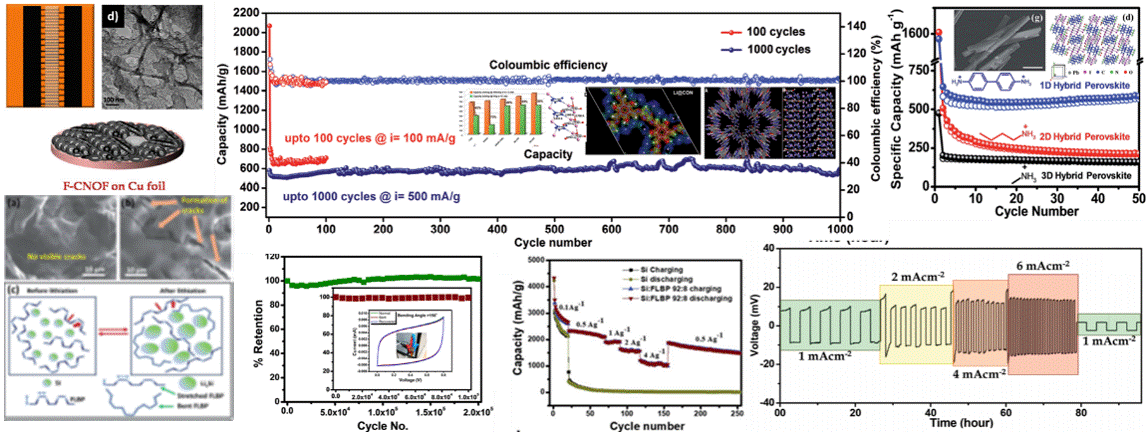 |  |
|---|---|
 |  |
 |  |
 |  |
 |  |
 |  |
 |  |
 |
"Resources are limited, but creativity is unlimited"
Research



1. Hybrid perovskites and Solar cells:
Hybrid Organic – Inorganic Pervoskites (HOIP’s) are the latest photovolatic materials of choice due to their superior charge transport properties such as low exciton binding energy, high in plane conductivity, micro-meter scale electron diffusion lengths along with easy solution processibility and high tunability which includes band dap and dimensional tunability. We are focused upon design, synthesis and development of novel 3D, 2D, 1D and 0D HOIP’s using new synthesis techniques or by incorporation of novel cations/dopants/2D materials. These HOIP’s are specifically designed towards property enhancements such as optoelectronic properties, charge carrier dynamics, photoluminescence properties, etc, which ultimately delivers high performance solar cells and light emitting diodes.
2. Green energy and energy storage devices:
The modern electrically driven world largely depends on the availability of efficient and robust energy storage devices, both stationary and transportable. In this regard, both alkali ion batteries and supercapacitors have made a significant landmark in the last few decades. Our lab focuses on synthesis and optimizing different electrode materials both for batteries and supercapacitors. This includes synthesis of various types of carbonaceous materials; binary, ternary and quaternary metal oxides, sulphides, phosphides and carbides; several alloying materials like Si, Sn, Ge etc along with different alloying cum conversion materials to use as anode materials both for Li and Na ion batteries. Besides, we do significant work on designing different kind of cathode materials which mainly includes ternary and quaternary metals oxide, oxo-halides, sulfates, phosphates etc. We are also working on optimizing different electrolyte additives. Our lab also focuses on fabricating supercapacitor devices which includes both symmetric and asymmetric supercapacitors along with flexible in-plane all-solid state microsupercapacitors.
3. Emergent phenomena in thin films and heterostructures by PLD:
Advances in the structure-property relationships underlie many 20th century technology innovations, new emergent phenomena and will continue to do so into the future. Dimensionality controlled TMOs are increasingly attracting attentions as an arena in which to search for unusual quantum correlated phenomena in condensed matter physics; e.g. magnetism, ferroelectricity, quantum spin-liquid (QSL), high temperature superconductivity (HTSC), quantum Hall effect (QHL) and non-trivial topological phenomena. These phenomena are proposed to derive from the interplay between electronic correlations, crystal field effects, strong spin-orbit coupling (SOC) and predominantly the dimensionality. Our goal is to synthesize highest quality epitaxial 2D heterostructures and superlattices by pulsed laser deposition (PLD), to play with their internal degrees of freedom to exploit the structure–property relationships, to find the next-generation multi-functional materials in view of application and of fundamental interest.
4. Photo-catalytic water splitting and CO2 reduction:
Photocatalytic and Photoelectrochemical water splitting for hydrogen generation and CO2 reduction to green fuel through engineered nanomaterials is our prime goal. We focus on design and development of new semiconductors as photocatalyst by constructing nanostructures, heterostructures with other materials or through defect engineering. Emerging 2D materials such as graphene, Maxene and C3N4 are employed in catalysis due to their unique optoelectronic properties. In composite kind of photocatalytic system, the two materials are selected and promoted to favor Z scheme mechanism to obtain high yield and selectivity. Overall, wide range of photocatalytic systems and different class of photocatalysts are considered to increase the solar efficiency.
5. Nano-generators, peizo and ferroelectric materials:
Nanogenerators have applications in internet of things that is made of billions of moving objects, wearable/flexible electronics that will transform every corner of our life, human machine interfacing for robotics and artificial intelligence, implantable medical devices, health care, self-powered sensors for infrastructure monitoring, and national security. Major multinational corporations are investing extensively in this technology, e.g., Samsung (powering wearable electronics), Hyundai (pressure monitoring and door lighting), Lenovo (smart keyboard), and Medtronic (pacemaker). The technologies originating inventions have the potential of significant impact in addressing societal challenges such as those related to energy harvesting from large scale motions, security through embedded sensors, and human lifestyle and welfare with self-powered gadgets as well as medical devices. Our research provides specialization of fabrication of Piezoelectric Nanogenerator (PENG) and Triboelectric Nanogenerator (TENG) which is referred to as the energy for the new era. In terms of materials, we are working on piezoelectricity in 2D materials and different polymers composition with the application to harvest energy from human activities, rotating tires, ocean waves, mechanical vibration and more, with great applications in self-powered systems for personal electronics, environmental monitoring, medical science and even large-scale blue energy from ocean water wave.

